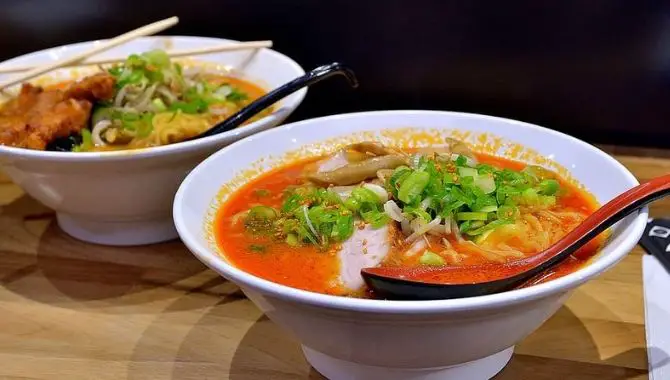Ramen noodles are one of my favourite foods. They’re so quick and easy (not to mention cheap). You can dress them up with lots of tasty, healthy ingredients, or eat them just as they come. The best thing about ramen noodles? They’re completely vegan.
There are some caveats, of course. The broth base that comes with most ramen noodles is often loaded with animal ingredients — not to mention sodium and other unhealthy additives. Strict vegans also need to watch out for palm oil and other less cruelty-free ingredients.
Is ramen vegan? Plain ramen noodles are made with ingredients of plant origin. Many packaged ramen meals come with a soup base or sauce that has meat, fish or other animal ingredients. A lot of ramen noodles contain palm oil, a vegetable oil that many vegans avoid.
Is ramen vegan? What are ramen noodles made of? Why are some ramen noodles vegan and others not? What ramen ingredients should vegans look out for? Where can vegans get ramen noodles? Are ramen noodles healthy? How can you make a bowl of ramen healthier and more satisfying? If you’ve arrived on this page, it’s because you’ve got questions about this favourite budget food and its suitability for your vegan diet.
We’ve got the answers you’re looking for. Read on to find out more about how to enjoy your favourite noodles without compromising your vegan ethics.
Is ramen vegan?
When I was first getting used to my vegan diet, ramen noodles were one of the things I missed. I remember complaining to a more seasoned vegan friend about how much I missed a nice, easy bowl of noodles when I wanted a hot meal I didn’t have to cook. My friend was baffled, and told me that she ate ramen all the time.
“But don’t they have egg?” I asked, surprised. She helpfully explained to me that while egg noodles certainly existed, the blocks of ramen that you can buy in the shops are typically egg-free. Completely vegan ramen can be a little hard to find, but it’s certainly out there. Join me as I describe the saga of my quest for the perfect instant vegan ramen.
In fact, the native state of ramen noodles is deliciously, guiltlessly vegan. The basic ramen noodle is made up of starch (sometimes wheat, sometimes potato), oil, and water. The dough is extruded into noodles and then dried in an oven. So far, so cruelty-free.
Problems start to arise when you look at the extras that come with your little block of twisty ramen noodles. In the most basic brands, this will be a sachet of powdered broth mix to give your noodles a little more flavour. (And salt; so much salt.) Better-quality ramen brands may contain several little packets with extra ingredients to jazz up your noodle snack. Unfortunately, these handy little sachets are often the downfall of an otherwise vegan dish. All to often, they are packed with animal ingredients. Beef or chicken stock, fish sauce, bonito flakes, sometimes whole dried shrimp. Even if you choose flavours like vegetable or chili, you can find animal ingredients lurking in the broth.
If you’re careful, you can find plenty of ramen noodles that don’t come with surprise dead shrimp. Some of them even claim to be vegan. Problem solved, right? Well, not quite. We still have to talk about palm oil. Although it’s technically vegan, the environmental impact of palm oil is harsh enough to knock it off most vegan shopping lists.
Palm oil: Is it vegan?
If your veganism isn’t particularly strict, then animal-free ramen may be good enough. Some vegans are content to avoid ingredients that are directly derived from animals, like meat, dairy, and eggs.
Some of us — myself included — take things a little further. If you’re a vegan motivated by animal welfare and care for the environment, your concerns don’t stop with ingredients of animal origin. There are certain ingredients that are made using procedures that make them, in my opinion, non-vegan. I’m not the Vegan Police and I certainly wouldn’t criticise another veegie if they happened to consume these; I just choose to avoid them myself.
One is sugar, an ingredient found in some ramen packets. You’d think that sugar was vegan right? Unfortunately, it’s often refined using a material called bone char. This is exactly what it sounds like: a substance made from carbonised animal bones. No, thank you.
Another, and perhaps more serious concern, is the presence of palm oil in many (if not most) brands of ramen. Most palm oil is produced in ways that are nothing short of horrific. Vast tracts of forest are burned to make way for palm plantations, killing countless animals and destroying their habitats forever. The effect on the local environment is devastating, stripping away the forest and replacing it with vast areas growing nothing but palm oil. Endangered animals, including the increasingly vulnerable orang-utan, are viciously beaten and slaughtered.
The misery doesn’t end when the plantation is established. The workers are treated almost as badly as the animals. They’re often forced to work long hours in unbearable conditions. In many cases, the workers are assisted by their own children. It’s the only way to meet the draconian quotas demanded by the plantation owners.
Despite some efforts to create sustainable, cruelty-free palm oil plantations, the current situation is that all palm oil must be assumed to be produced using cruel, dangerous, and environmentally unfriendly methods. From my point of view, that makes it non-vegan.
True vegan ramen
At this point you may have thrown up your hands and started shopping for a pasta machine. Don’t give up yet, though — truly vegan ramen is in sight. There are a few brands that are completely vegan, made with organic ingredients, and free from the palm oil discussed above.
Be aware that vegan ramen noodles are a little more expensive than the cheap ones you get from the store. They’re still a great budget option, just as convenient as regular ramen, and very tasty.
If you’re looking for a standard block of ramen, the kind that comes with a sachet of broth, my stand-out favourite is Koyo Ramen. Koyo ramen noodles are organic, GMO free and palm oil free. There are several delicious vegan flavours, including shiitake mushroom, tofu miso, lemongrass ginger and wakame seaweed. As you can see, the flavours are a little more interesting than your typical supermarket noodle. They’re baked rather than fried and pack less of a saturated fat punch.
For those who are less picky about palm oil, the flavours I hear everyone raving about are Nissin Top Ramen in Soy Sauce and Chili. While they’re not palm oil free, they do come with no animal ingredients.
If you fancy something a bit different, you could try other types of noodles. Fresh noodles are a good option, as they’re not fried in palm oil to dry them out. You can keep them in the fridge until you’re ready for a quick meal, adding the noodles to the soup base or stir-fry of your choice. Mung bean “glass noodles” are delicious and have an enticing translucent appearance. Hearty buckwheat soba noodles can be found in Asian stores; they’re usually made without eggs, although your should of course check the ingredients.
For those who really want to control every aspect of what they eat, making your own noodles is certainly possible. The best way to do this is with a pasta machine. Homemade ramen dough is pretty simple — mostly wheat and flour. Traditionally the recipe calls for an alkaline fluid called kansui, which vastly improves the texture. You can usually find this in your local Asian store. It’s a little tedious, but once you’ve made a big batch of ramen you can dry it in a slow oven or freeze it for the next time you fancy a quick and satisfying meal.
Welcome to VeganClue - My name is Robert Van De Ville and together with my team we spent hundreds of hours researching the most relevant topics for Vegans and non yet Vegans. Are you looking for more information about Veganism, animal welfare, diet, health, and environmental benefits of the Vegan lifestyle? You are in the right place! Enjoy the site.

